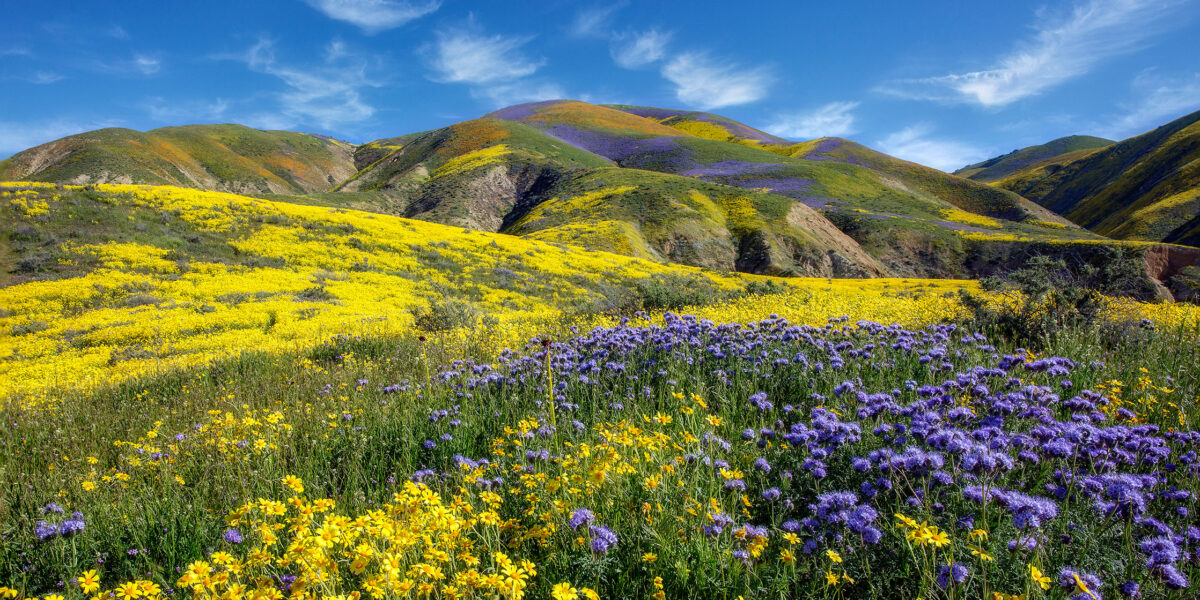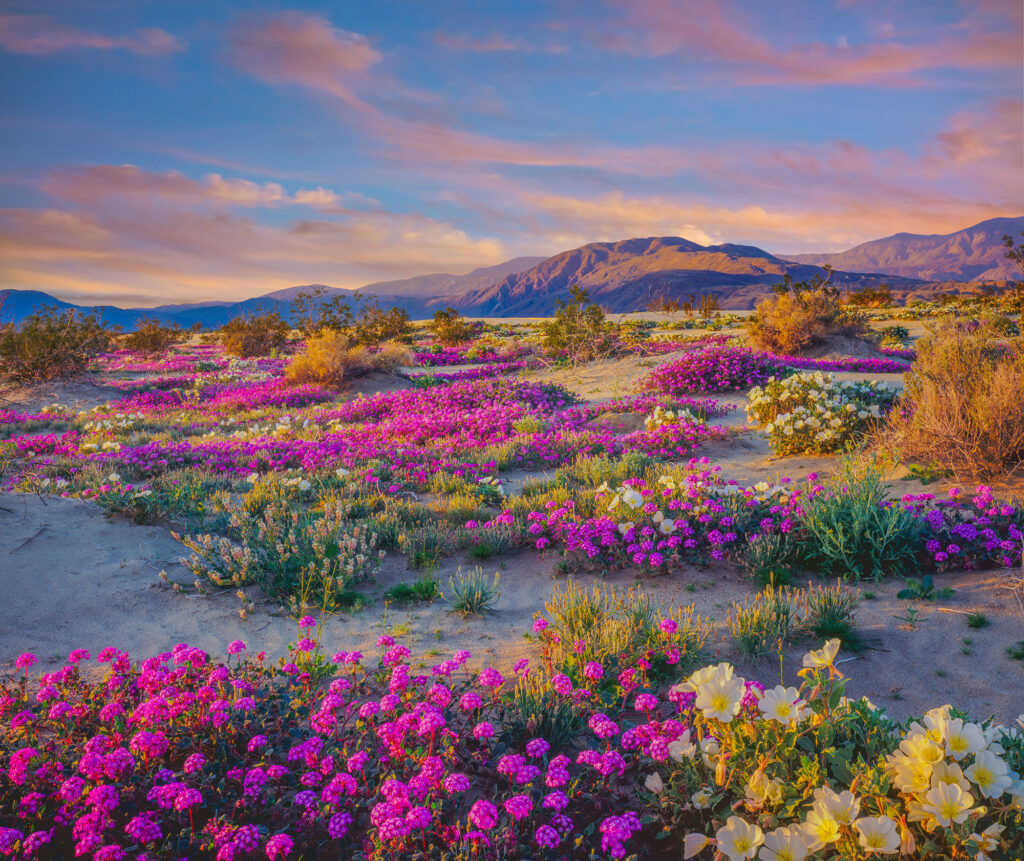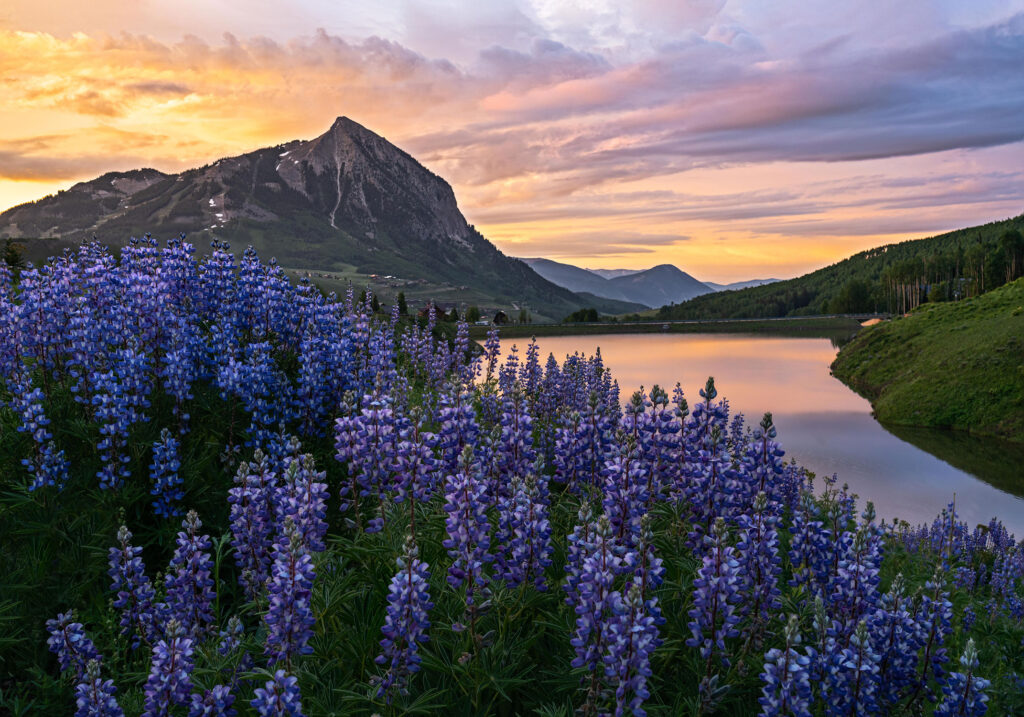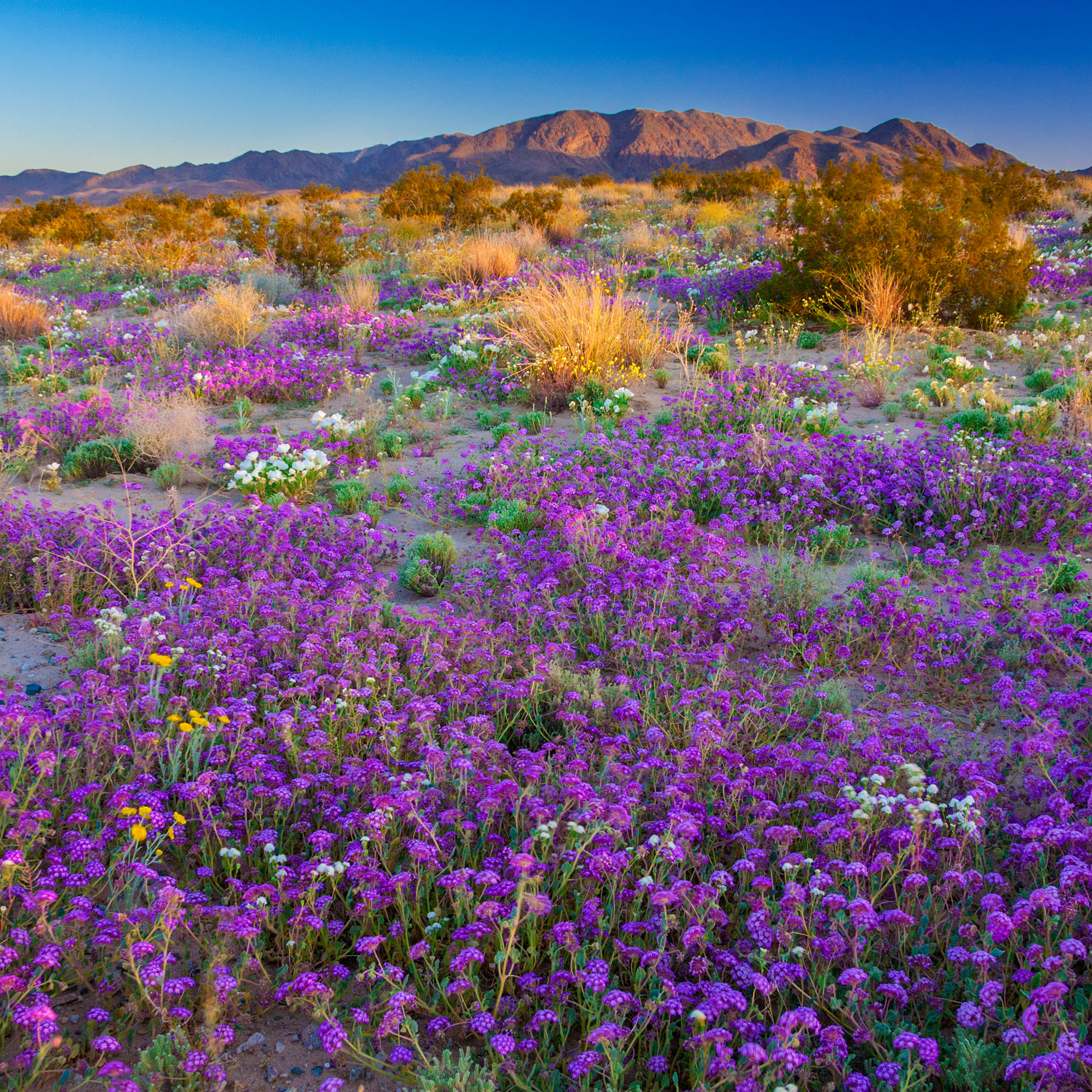
Where to See Some of Spring’s Most Spectacular Blooms in the West
Visit these hidden gems during your travels this season.

Jon Farmer/Getty Images
Spring in the West is nothing short of magical, with an explosion of color painting the landscape across the region. From tulip fields in Oregon to the desert’s stunning wildflowers, this season offers a floral spectacle like no other. Whether you’re chasing the superbloom, wandering through a botanical garden, or discovering bloomage in a new part of the West, there’s a spring flower-filled destination waiting for you. We’ve rounded up a few of the best places to catch peak bloom this season, plus essential tips to help you make the most of your petal-peeping adventure.
California

Ron and Patty Thomas/Getty Images
Anza-Borrego Desert State Park Superbloom
Where: Borrego Springs, California
Best time: February–April (depends on winter rains)
What to see: When conditions align, this park erupts in a superbloom of desert lilies, sand verbena, and bright-orange poppies. Start at the visitor center for the latest bloom reports and best trail recommendations.
Carrizo Plain National Monument
Where: San Luis Obispo County, California
Best time: March–April (after a wet winter)
What to see: California’s largest remaining grassland puts on a show with neon-orange California poppies, deep-purple phacelia, and bright yellow goldfields carpeting the Temblor Range. It’s one of the most dramatic wildflower displays in the state—like stepping into an impressionist painting.
Lompoc Flower Fields
Where: Lompoc, California
Best time: April–June
What to see: Tucked along California’s Central Coast, Lompoc’s rolling hills explode with vibrant rows of stock, larkspur, sweet peas, and delphiniums each spring. While these commercial fields don’t have designated viewing areas, scenic drives along Floradale Avenue and Central Avenue offer stunning roadside views. For a closer look, visit during the Lompoc Valley Flower Festival in June, when the town celebrates its floral bounty with parades, local art, and fresh blooms.
Mendocino Coast Botanical Gardens
Where: Mendocino, California
Best time: February–May
What to see: This stunning coastal retreat explodes into Camellias, magnolias, cherry blossoms, and 124 species of rhododendrons, which have their own festival in May. The garden’s collection of heritage rhodies dates back to the 1940s and is a must-see for flower lovers.
Pacific Northwest

strekoza2/Getty Images
Columbia River Gorge Wildflowers
Where: Mosier Plateau and Tom McCall Preserve, Oregon
Best time: April–May
What to see: Hillsides covered in Arrowleaf Balsamroot (golden sunflower-like blooms), lupine, and Indian paintbrush. Hike the Tom McCall trail for a 360-degree view of the Columbia River framed by a sea of yellow and purple blooms.
Skagit Valley Tulip Festival
Where: Mount Vernon, Washington
Best time: April
What to see: Endless rows of tulips in vibrant hues stretch across the valley, making this one of the most stunning floral displays in the country. Visit RoozenGaarde, Tulip Town, Tulip Valley Farms, and Garden Rosalyn for the best views. Arrive early to beat the crowds, and take a scenic drive through Skagit Valley to see why it’s the top tulip and daffodil bulb producer in the U.S. Bonus: The fields also provide critical habitat for thousands of swans and snow geese.
Washington Park Cherry Blossoms
Where: Portland, Oregon
Best time: March–April
What to see: While cherry blossoms are more famous in Washington, D.C., Portland’s Washington Park and the waterfront area burst with delicate pink and white blooms in early spring. It’s one of the city’s best-kept seasonal secrets. Pro Tip: If crowds are too much, you can also catch cherry trees popping off at Tom McCall Waterfront Park and Japanese American Historical Plaza.
Wooden Shoe Tulip Festival
Where: Woodburn, Oregon
Best time: Late March–April
What to see: Think Holland, but make it Oregon. This sprawling farm near Portland features over 40 acres of technicolor tulips in every shade imaginable. The festival also offers sunrise hot air balloon rides, wine tastings, and farm tours.
Desert & Southwest

silvermanmediaservices/Getty Images
Boyce Thompson Arboretum
Where: Superior, Arizona
Best time: March–May
What to see: Arizona’s largest botanical garden is where cacti and wildflowers collide. Expect bright bursts of desert marigolds, globe mallows, and brittlebush, plus towering saguaros crowned with white blossoms. Wander among prickly pears, palo verde trees, and cholla cacti, all showing off their spring colors. Pro Tip: Keep an eye out for rare blooms like Karoo Boer-bean trees (a hummingbird favorite) and the giant white Matilija poppy, plus a stunning mix of wildflowers and desert plants in shades of yellow, orange, red, and pink.
Great Basin National Park’s Alpine Wildflowers
Where: Baker, Nevada
Best time: May–July
What to see: A hidden gem for wildflower lovers, Great Basin features an incredible variety of blooms. Evening primrose, desert mallow, golden peas, and paintbrush are early-season highlights, while later months bring segos, shooting stars, yarrow, and delicate columbine. Take the Wheeler Peak Scenic Drive for a drive-by wildflower show or hike the Sky Island Forest Trail for alpine blooms at over 10,000 feet. For variety, the Baker Creek Loop serves up a range of habitats, from lush meadows to arid slopes, with new wildflowers blooming all summer.
Mountain West

Tom Kingsford
Crested Butte Wildflower Festival
Where: Crested Butte, Colorado
Best time: July (though spring wildflowers begin in May)
What to see: Dubbed the Wildflower Capital of Colorado, this high-altitude haven bursts into full bloom by summer. But if you visit in spring, you’ll spot early bloomers like pasqueflowers and glacier lilies, with hints of the season ahead. Bonus: It’s one of the best places to find the elusive blue columbine, Colorado’s state flower. Plan for July’s 10-day Wildflower Festival, featuring guided hikes, painting, photography, and pollination workshops in peak bloom.
Red Butte Garden
Where: Salt Lake City, Utah
Best time: March–May
What to see: This Intermountain West gem erupts with daffodils, snowdrops, reticulated iris, and Siberian squill in early spring, followed by a rolling bloom of glory-of-the-snow and other bulbs through May. Pro Tip: Visit often—different bulbs peak at different times, and blooms shift with the weather. Don’t miss the Rose Garden, Orangerie, and Utah Native Collection for more seasonal color.
Zion National Park Canyon Wildflowers
Where: Zion National Park, Utah
Best time: April–June
What to see: Spring transforms Zion’s red rock canyons with bursts of golden columbine, Zion milkvetch, and desert paintbrush. Early bloomers like desert marigold pop up in lower elevations (Coalpits Wash), while canyon floors peak in late spring and higher trails bloom into June. Walk the Riverside Trail for lush foliage, or visit Weeping Rock and Emerald Pools for hanging gardens of shooting stars and scarlet lobelia. Keep an eye out for Utah penstemon, desert phlox, wild flax, and even edible miner’s lettuce along the trails.
Hawaii & Alaska
Allerton Garden
Where: Kauai, Hawaii
Best time: Spring–Summer
What to see: Nestled in the lush Lawai Valley, Allerton Garden is a tropical paradise filled with vibrant blooms that range from bright hibiscus to fragrant plumeria. The garden is famed for its stunning landscape, which includes cascading waterfalls and pristine lagoons. As you wander through this botanical gem, you’ll also spot towering banyan trees and colorful heliconias—ideal for those seeking a more tranquil, less touristy spot to appreciate Hawaii’s diverse flora.
Charles Georgeson Botanical Garden (University of Alaska Fairbanks)
Where: Fairbanks, Alaska
Best time: Late spring–early summer
What to see: A quiet gem tucked in Fairbanks, this botanical garden showcases northern wildflowers in their full spring glory. Known for their peonies—which bloom in June and July—don’t miss the Display Garden where spring staples such as violets, columbines, dahlias, sweet peas, lilacs, and daylilies will inspire the cottage garden of your dreams. The garden is a peaceful escape where you can learn about native plants and how they adapt to Alaska’s cooler temperatures. It’s a serene spot for plant enthusiasts and those curious about the region’s horticultural wonders.
Hawai’i Tropical Botanical Garden
Where: Big Island, Hawaii
Best time: Year-round (spring for peak blooms)
What to see: Nestled in the Onomea Valley, this lush, 40-acre garden features a stunning collection of orchids, heliconias, and rare tropical blooms. Enjoy vibrant flowers set against the breathtaking Pacific backdrop. Explore the Palm Jungle, hike to Onomea Falls, or simply soak in views of Onomea Bay. Don’t forget to bring sturdy shoes, insect repellent, and water for the trails!
Kincaid Park
Where: Anchorage, Alaska
Best time: Late spring
What to see: Kincaid Park offers a more laid-back wildflower experience with meadows filled with lupine, Alaska primrose, and wild iris. This local park, just outside Anchorage, gives you a quieter, more intimate experience compared to the city’s bigger, more popular spots. Explore its winding trails for stunning views of the coastline and nearby mountains, all while enjoying spring blooms in their natural habitat. Perfect for a peaceful walk or a quiet afternoon of nature watching.
Tips for Planning Your Trip

David H. Carriere / Getty Images
- Check Bloom Reports
Wildflower seasons can vary, so it’s important to stay up-to-date on bloom timing. Superblooms and peak seasons shift from year to year based on weather conditions. Local parks, botanical gardens, and websites dedicated to wildflower tracking can offer real-time updates. Apps like Wildflower Search and bloomWatch are great resources to monitor where flowers are popping up and to ensure you catch them at their peak.
- Go Early—or Late!
Spring wildflower destinations are often popular, and if you’re hoping to capture that perfect shot or enjoy a quiet moment in nature, timing is key. Arriving at sunrise or opting for a late afternoon visit can help you avoid the crowds and offer the best lighting for photos. Plus, early mornings tend to bring crisp, dewy landscapes, while late afternoons bathe flowers in a warm, golden glow. - Respect the Flowers
Wildflower habitats are delicate, and it’s crucial to tread lightly. Stay on designated paths to protect both the plants and the surrounding ecosystem. Avoid picking flowers, as tempting as it might be, and resist the urge to wander off-trail. Leaving nature undisturbed ensures that others can enjoy the blooms long after you’ve gone. Follow “Leave No Trace” principles to minimize your impact and preserve these stunning environments for future generations. - Pack for the Season
While spring in the West can mean bright, sunny days, it can also bring unpredictable weather, especially in higher-altitude areas. For locations like Crested Butte, Colorado, or Nevada’s Great Basin, it’s not uncommon to find snow patches lingering into spring. Be prepared with layers, sturdy shoes, and weather-appropriate gear. A light jacket or sweater can come in handy, and don’t forget sunscreen and a hat for sun protection. - Be Mindful of Timing
Not all blooms happen simultaneously. Some areas are known for earlier flowers (like California’s poppies), while others may reach their peak later in the season (such as higher-altitude meadows). If you’re planning a multi-location trip, research the best times for each spot to maximize your chances of seeing the full spectrum of spring blooms.
